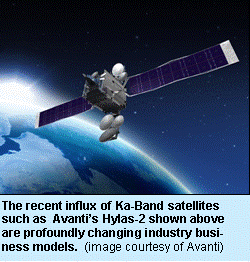Ka-Band: Driving Profound Business Model Changes
by Jan Grøndrup-Vivanco
Paris, September 4, 2012--Ka-band is more than just an expansion band; it will have profound implications on how satellite capacity is sold from both the satellite operators’ and service providers’ perspective. One might even worry if Ka-Band is short for cannibalism? Even though Ka-Band has been around for a number of years in the satellite communications industry, it is only recently that it has made inroads into the commercial mainstream as C- and Ku-Band.
Ka-Band has gone from being the equivalent of a “school science project” for the satellite operators to a key element in their expansion strategies. Satellite operators Eutelsat and Avanti have launched Ka-Band only satellites and most new satellites have or will Ka-Band payloads, like Telenor’s Thor 7 or even Azerbaijan’s first satellite, Azercosmos-1 scheduled to be launched in 2013. Intelsat’s future Epic constellation will integrate Ka-Band with C and Ku-Band payloads on the same satellite, and Inmarsat’s Global Xpress constellation is all Ka-Band enabling Inmarsat to serve both fixed and mobile users.
This is driven by two factors. The first one is that Ka-Band is increasingly the only available expansion path to get additional bandwidth, due to the C- and Ku-slots being saturated with existing satellites. The second reason is that Ka-Band will effectively enable to lower the price of bandwidth seen from an end-user perspective. O3b, in which SES is a strategic shareholder, is also an all Ka-Band constellation, is targeting the wholesale market for IP Backhaul. O3b aims at achieving price points that are “2-3 times lower” compared to similar prices on C- and Ku-Band. O3b is confident that they will be able to revitalise the backhaul via satellite market, which for a long time has been in declined due to submarine cable roll-out rendering satellite backhaul in C- and Ku-Band increasingly uncompetitive. With spot beams and frequency re-use such lower price points certainly looks achievable and O3b is not alone in being able to significantly lower the effective end-user price.
 Overall this is good news for the satellite industry that again will be able to “reinvent” itself. Back then when broadcasting was all analog and one entire transponder was needed per TV channel, there were about 200 TV channels broadcast on all satellites worldwide. Moving to digital broadcasting meant that broadcasters were able to broadcast 8-10 or more TV channels per transponder, effectively lowering the user price by a factor 10 per TV channel.
Overall this is good news for the satellite industry that again will be able to “reinvent” itself. Back then when broadcasting was all analog and one entire transponder was needed per TV channel, there were about 200 TV channels broadcast on all satellites worldwide. Moving to digital broadcasting meant that broadcasters were able to broadcast 8-10 or more TV channels per transponder, effectively lowering the user price by a factor 10 per TV channel.
After a decade of moving to digital satellite broadcasting about a total of 20,000 TV channels were broadcast on satellite, i.e. a factor of 100 increase and net leverage of a factor of 10.
It therefore likely that lower Ka-Band price points will drive up demand, at least in the longer term. That’s the good news. However, there are a couple of differences this time around this time, which both operators and service providers need to be conscious of and start to plan for already now.
Without getting into too many technical details, it is important to note that most Ka-Band systems are integrated “closed” systems with the satellite operator managing both the space and ground segments, in contrast to the transparent “bent pipe” provided on conventional C- and Ku-Band satellites, where the ground systems are typically managed by teleports or service providers.
Moreover most Ka-Band satellites use spot beams covering a relatively small geographical area on the earth normally a few hundred kilometres in diameter. Each beam typically only communicates into a single a gateway. In other words, Ka-band satellite systems are usually star configurations, and communication between two remote stations needs to transit through the gateway. Ka-sat from Eutelsat and Avanti’s Hylas satellites are examples of “closed systems” where these operators are managing both the space and ground segments.
It may not be obvious but this technical difference will have a major commercial impact in the whole satellite communication ecosystem of operators, service providers and resellers.
Eutelsat has focused on selling their Ka-Sat as “managed services” through a range of mostly new resellers, instead using their existing base of service providers and teleports. Abu Dhabi based Yahsat is a newish satellite operator which wholesales their C- and Ku-Band capacities, as well as marketing their “YahClick” Ka-based “managed” broadband services via resellers.
The consequence on the distribution level is that most Ka-Band capacities will no longer be sold by satellite operators as raw capacity, but rather as managed services.
Mobile Satellite Services (MSS) operator Inmarsat has for a number of years operated as a “closed” system with their L-Band offerings and this has meant that they mainly commercialized their services through resellers, however for the majority of the other satellite operators this is new.
Most Fixed Satellite Services (FSS) operators have to a large extend been selling their capacity in a commodity type market environment with limited means to differentiate their offering, except for the relatively few satellites that were able to establish themselves as “hot birds” for Direct-to-Home (DTH) broadcasting and cable contribution, and thus being able to command premium prices.
Even if the “satellite operator–service provider” distribution model to some extend consigned the satellite operators to be commodity-like capacity sellers for non-hot bird capacities, the operators also greatly benefited from this financially by offloading the distribution risk to teleports and service providers channels. These distribution channels bought in volume to get competitive prices, carried the inventory and assumed the technology and end-user credit risk.
Today and for a foreseeable future the service providers will carry the vast majority of the satellite operators inventory of raw C- and Ku-Band capacity, and thus will continue to provide the majority of the revenues for the satellite operators.
While Ka-Band certainly offers some interesting price points for a consumer types of “broadband via satellite” propositions, we have lately seen that satellite operators marketing these services are now also starting to address the wholesale market with their Ka-Band capacities, presumably because the broadband via satellite consumer markets have taken longer time to develop than initially forecasted, mainly due to lack of efficient reseller channels.
The key issue for the operators is how to balance selling their managed services at prices which on a Megabit level is lower compared to what their service provider channels can achieve with their existing (and future) C- and Ku-Band inventories. This creates an interesting conundrum for the satellite operators, as they will need to manage the inevitable channel conflict between the “wholesale” and “managed services” channels. This will not be easy.
SES is addressing this issue by taking a more cautious approach to Ka-Band and has stated that they will not launch an all Ka-Band satellite and therefore presumably not offer consumer broadband via satellite through a parallel network of resellers. SES’s strategy is to increase its Ka-band capacity, by adding a number of Ka-Band transponders to four of its European satellites to be launched in the coming two to three years. This will be “open system” or “bent pipe” Ka-Band capacity and likely be marketed as traditional wholesale capacity to its service provider channels.
An option for satellite operators wishing to market their capacities both as wholesale capacity and manage services is to have a clear separation between the two and create a “Chinese wall” between their wholesale and managed services businesses, where the managed service entity buys capacity on a wholesale basis on similar terms as the other wholesale channels and the commercial relationship is managed on an arms length basis. There are many examples of how not to do this, because the managed service entity is “too close” to the operator itself and the other service providers feel that they are the victims of “corporate nepotism.”
However, with a well thought through set-up and right corporate governance, for instance autonomous management and possibly also a semi-independent board, this offers a way for the two distribution models to co-exist under the same corporate umbrella. Service provider Speedcast of Hong Kong, which is majority-owned by satellite operator Asiasat, is a good example of such a set-up.
Similarly it is urgent for service providers and teleports who today contract for raw capacity on wholesale basis to rethink how to contract for future satellite capacities, with the disruption Ka will bring. Whilst it is unlikely that these B2B service providers will be able to serve consumer broadband customers effectively, it is feasible that a repackaged Ka-Band service could be offered to their corporate customers. Ka-Band services for the SOHO and SME markets, for instance in Eastern Europe, offer interesting entry-level packages for such customers that are not able to afford a more expensive VSAT service. With the slow uptake of Ka-Band consumer services, teleports and service providers now have an opportunity to engage with the satellite operators to discuss how they can help to market such managed services and integrate their services with the satellite operators on a hub level.
Ka-Band is still in its commercial infancy and both satellite operators and service providers should already now be pro-active about defining their distribution strategies and place in the value chain in this respect. It is possible for both operators and service providers to create “win-win” situations to manage this transition that Ka-Band will bring.
---------------------------------------------
 Jan Grøndrup-Vivanco is a Director in Emerald Advisors, a strategy & business development advisory firm to the satellite communication industry. He can be reached at jgv@emerald-advisors.com
Jan Grøndrup-Vivanco is a Director in Emerald Advisors, a strategy & business development advisory firm to the satellite communication industry. He can be reached at jgv@emerald-advisors.com





